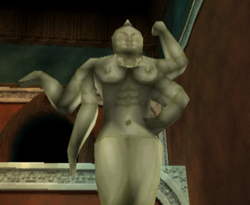Four-armed statue: Difference between revisions
DansFriend (talk | contribs) No edit summary |
DansFriend (talk | contribs) mNo edit summary |
||
| Line 9: | Line 9: | ||
*[[The Museum]]}}}} | *[[The Museum]]}}}} | ||
}} | }} | ||
A '''four-armed statue''' was exhibited in the [[The Museum|Great Museum]] in [[Kensington]], [[London]] in the late 19th century. | A '''four-armed statue''' was exhibited in the [[The Museum|Great Museum]] in [[Kensington]], [[London]], in the late 19th century. | ||
==History== | ==History== | ||
===Origin=== | ===Origin=== | ||
Revision as of 21:42, 7 February 2025
| Four-armed statue | ||
|---|---|---|

| ||
| General information | ||
| Type | Statue | |
| Gameplay information | ||
| Entity name | MUStatue | |
| Behind the scenes information | ||
| Appears in | ||
A four-armed statue was exhibited in the Great Museum in Kensington, London, in the late 19th century.
History
Origin
Though its exact origin was obscure due to a lack of labeling in the museum, the statue's general appearance suggested a possible South Asian origin. This is further supported by the British Empire's colonisation efforts in the region during the time period.
As an exhibit
The statue was on display in one of the rooms of the Kensington museum. In 1886, during the Autumn of Death, a giant reanimated skeletal dinosaur managed to knock it over by roaring. This allowed the resurrected hero Sir Daniel Fortesque (a fellow museum exhibit) to progress further into the museum by climbing on the knocked over statue.[1]
Characteristics
Appearance
The statue depicted a largely naked humanoid figure (likely a Dharmic deity) with four arms. The figure wore a spiked hat on its head and an elaborate necklace around its neck. It had a prominent pair of breasts and strongly defined abdominal muscles.
Gallery
References
- ↑
 MediEvil 2. Developed by SCEE Cambridge Studio. Published by Sony Computer Entertainment on April 21, 2000.
MediEvil 2. Developed by SCEE Cambridge Studio. Published by Sony Computer Entertainment on April 21, 2000.
| ||||||||||||||||||||||||||||||||||||||


